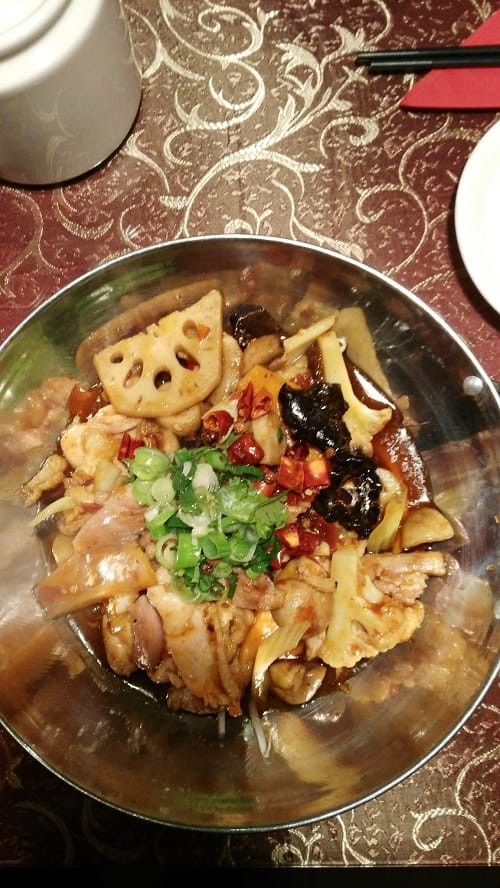What’s the best way to tell area residents about plans for a new asylum shelter nearby?
The government should tell communities directly about plans for new asylum shelters, some activists and politicians say.
While many associate Chinese food with sweet, sticky sauces, there is another, more authentic set of dishes available to those who ask.

On a Saturday afternoon in Parnell Street’s Lee Kee restaurant, afternoon diners share quiet conversation over bowls of steaming broth.
There are gleaming metal pots on red-and-gold tablecloths, piled high with meat and vegetables, sizzling over Bunsen-style flames.
In the heart of Dublin’s Chinatown, restaurant owner Rikan Liu says Parnell Street is the only place to get real Chinese food in the city. “Some people want to stay in Dublin 2, they don’t want to come to Parnell Street,” he says.
One day, he wants to sell the restaurant and open another closer to the centre, serving real, traditional Chinese food, he says.
Some people think takeaway is close enough, but he says it couldn’t be more different.

It’s no secret that curry chips isn’t a traditional Chinese dish.
Many restaurants still offer two menus: one standard English-language, and one lesser-known Chinese-language menu.
There’s a practical reason for this: many Chinese people living in Dublin don’t speak English, according to Lee Xu, manager at Sichuan Chilli King on Parnell Street.
As a result, it’s usually the Chinese customers who order from this second menu, so the dishes are often closer to traditional Chinese food than European-style Chinese food.
Some of the dishes are the same, but there are some notable differences. Some Irish people think it’s crazy that they serve beef and pork stomach, says Liu.
The duck blood dish stands out, as does the pork blood with beef and pork stomach. But the special mushroom dish is the spiciest thing on the menu.
Liu says that some people try the food, not knowing what it is, but afterwards they say it’s really good.
So many people ask for one menu, he says, that maybe one day he’ll combine them. It’s usually the old, regular customers who order from the Chinese-language menu.
His plan is to design a tasting menu so that people can try small portions of traditional foods. That way, he says, people will know what they want next time.
Chicken feet are not on the menu in Lee Kee, but even so, Liu says the chefs often prepare them for themselves and the staff. Hot, cold, steamed – and often with the bones left in.
Marcus Hoo is the manager at Wicklow Street institution Ka Shing, which serves chicken feet. He says Irish customers often don’t enjoy the dish, but they try it anyway.
Some people don’t like the texture, says Hoo – they say it’s like jelly – but they really enjoy the flavour.
Hoo says dim sum is very popular, though a few of the more traditional dishes contain bones, which is off-putting for some.
He says that from about 2009 onwards, Chinese food got a reputation as unhealthy, and restaurants began to struggle.
“Some people say, why would you pay more when you can go to a takeaway?” he says.

Sweet and sours, shredded chicken and curries are ever-present old-reliables, but in Lee Kee, even the English menu has more curious fare on offer.
For starters, there’s oyster and tofu soup, Chinese melon and sliced fish soup and jellyfish and cucumber salad.
Not all the traditional dishes are eye-wateringly hot, or made with lesser-known cuts. Mostly, it’s how the dish is cooked that makes it different.
A vegetable called morning glory is served in a special garlic sauce; it’s somewhere between spinach and spring onion, but silkier and slightly oceanic tasting. Liu says it’s typically Chinese, and difficult to source in Ireland.
Unlike a lot of takeaway food, the sauces are not thick with corn-starch and cloyingly sweet. The flavours are delicate.
Xu explains that a lot of popular Chinese food we have today is Hong Kong-style, which is quite different.
Twenty years ago, many people travelled from Hong Kong to Ireland on British passports, bringing sweeter flavours, and fish and chips, he says.
European people generally prefer the taste of Hong Kong food, and many find other Chinese dishes too spicy or salty, he says.
“Usually, if Irish people come in, and if they love Chinese food they will ask you, ‘Can I have a Chinese menu?’ and they can see the picture, even if they don’t understand what’s written.”
Xu says his Irish friends ask him why takeaway food tastes different to the restaurant’s food.
“If you go to a proper Chinese restaurant, they have to chop everything fresh, and there’s a different taste. It’s a skill,” he says.
The reputation of a restaurant is important, says Alex Sally, a regular customer back in Lee Kee. If people trust the place and its staff, they’re more willing to try new things.
Sally is from the Seychelles, but says the food in Chinatown reminds him of the food from home, which he misses.
“There’s a difference when people cook with passion,” he says, adding that it doesn’t have to be fancy or expensive.